Lab Safety Manual - UCLA - Environment, Health & Safety
Lab Safety Manual - UCLA - Environment, Health & Safety
Lab Safety Manual - UCLA - Environment, Health & Safety
You also want an ePaper? Increase the reach of your titles
YUMPU automatically turns print PDFs into web optimized ePapers that Google loves.
Chapter 6: Inventory, <strong>Lab</strong>eling, Storage, and<br />
Transport<br />
Regulatory Requirements<br />
Implementation of the necessary work practices, procedures, and policies outlined in this chapter is<br />
required by the following:<br />
Title 8, California Code of Regulations (CCR), Section 5164, “Storage of Hazardous<br />
Materials” (http://www.dir.ca.gov/title8/5164.html)<br />
Title 8, California Code of Regulations (CCR), Section 5191, “Occupational Exposures to<br />
Hazardous Chemicals in <strong>Lab</strong>oratories” (http://www.dir.ca.gov/title8/5191.html)<br />
Title 8, California Code of Regulations (CCR), Section 5194, “Hazard Communication”<br />
(http://www.dir.ca.gov/title8/5194.html)<br />
Title 8, CCR, Section 5209, “Carcinogens” (http://www.dir.ca.gov/title8/5209.html)<br />
Title 8, CCR, Section 5154.1, “Ventilation Requirements for <strong>Lab</strong>oratory-Type Hood<br />
Operations” (http://www.dir.ca.gov/title8/5154_1.html)<br />
Other applicable regulations include those promulgated by the U.S. Department of <strong>Lab</strong>or including 29<br />
CFR 1910.1450 "Occupational Exposure to Hazardous Chemicals in <strong>Lab</strong>oratories" (the "<strong>Lab</strong>oratory<br />
Standard").<br />
Chemical Inventories<br />
Each laboratory group is required to maintain a current chemical inventory that lists the chemicals<br />
and compressed gases used and stored in the labs and the quantity of these chemicals. Specific<br />
storage locations must be kept as part of the inventory list to ensure that they can be easily located.<br />
Chemical inventories are used to ensure compliance with storage limits and fire regulations and can<br />
be used in an emergency to identify potential hazards for emergency response operations.<br />
The chemical inventory list should be reviewed prior to ordering new chemicals and only the<br />
minimum quantities of chemicals necessary for the research should be purchased. As new<br />
chemicals are added to the inventory, each laboratory group must confirm that they have access to<br />
the <strong>Safety</strong> Data Sheet (SDS) for that chemical. Where practical, each chemical should be dated so<br />
that expired chemicals can be easily identified for disposal. Inventory the materials in your<br />
laboratory frequently (at least annually) to avoid overcrowding with materials that are no longer<br />
useful and note the items that should be replaced, have deteriorated, or show container<br />
deterioration. Unneeded items should be returned to the storeroom/stockroom and compromised<br />
items should be discarded as chemical waste.<br />
Indications for disposal include:<br />
Cloudiness in liquids<br />
Color change<br />
Chemical Hygiene Plan 6-1 January 2013
















